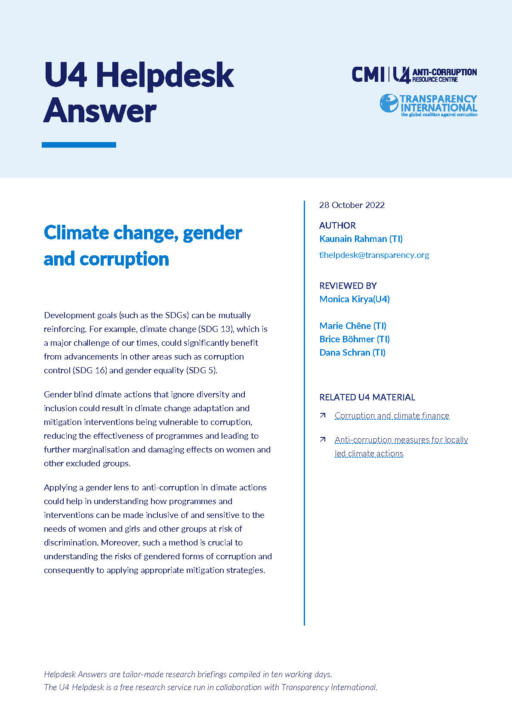
This Anti-Corruption Helpdesk brief was produced in response to a query from a U4 Partner Agency. The U4 Helpdesk is operated by Transparency International in collaboration with the U4 Anti-Corruption Resource Centre based at the Chr. Michelsen Institute.
Query
Please provide an overview of the existing literature, experiences and project examples on climate, gender and corruption. What are some of the gaps in research and practice, and what have we learned so far on how gender transformative approaches can make a difference in curbing corruption with regards to climate change mitigation and adaptation and a just energy transition?
Summary
Development goals (such as the SDGs) can be mutually reinforcing. For example, climate change (SDG 13), which is a major challenge of our times, could significantly benefit from advancements in other areas such as corruption control (SDG 16) and gender equality (SDG 5).
Gender blind climate actions that ignore diversity and inclusion could result in climate change adaptation and mitigation interventions being vulnerable to corruption, reducing the effectiveness of programmes and leading to further marginalisation and damaging effects on women and other excluded groups.
Applying a gender lens to anti-corruption in climate actions could help in understanding how programmes and interventions can be made inclusive of and sensitive to the needs of women and girls and other groups at risk of discrimination. Moreover, such a method is crucial to understanding the risks of gendered forms of corruption and consequently to applying appropriate mitigation strategies.
Contents
1. Background:
• Climate change, gender and corruption: Existing literature
• Project examples highlighting the need of incorporating gender sensitivity and anti-corruption in climate adaptation and mitigation interventions
2. Moving towards gender transformative approaches
• Gender transformative approaches to counter corruption in climate actions
• Importance of interlinking gender and corruption in climate actions
3. Anti-corruption in climate actions: Integrating a gender lens
4. References
Main points
- Interventions aimed at climate change, gender equality and anti-corruption can be mutually enforcing.
- Gender transformative approaches (GTAs) aim to address imbalanced power dynamics that feed corruption and discrimination cycles.
- Applying a gender lens to anti-corruption processes aimed at climate actions, could make them more inclusive of and sensitive to the needs of women and girls and help to address gendered forms of corruption such as sextortion.
- Anti-corruption efforts can be made gender responsive by including women in anti-corruption interventions, using social audits on women’s access to services, recognising and addressing gendered forms of corruption, such as sextortion, and having gender sensitive complaint mechanisms, among others.
Caveat
There is limited evidence of gender transformative approaches to counter corruption in climate interventions in the public domain. This Helpdesk Answer proposes ways to consider anti-corruption in climate actions through a gender lens, based on examples from approaches in other sectors. Disclaimer: The answer uses a binary understanding of the concept of gender (as men and women) solely because the available evidence follows this approach. There is no intention of diluting identities on the gender spectrum.
Authors
Kaunain Rahman (TI), [email protected]
Reviewers
Monica Kirya(U4)
Marie Chêne, Brice Böhmer and Dana Schran (TI)
Date
31/10/2022

